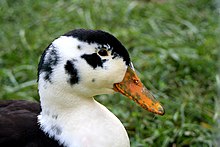TheMagpieis a Britishbreedofdomestic duck.[7][8][9]It has distinctive black and white markings reminiscent of theEuropean magpie,and is a good layer of large eggs.[10]: 46
 A drake | |
| Conservation status | |
|---|---|
| Country of origin | United Kingdom |
| Traits | |
| Weight |
|
| Classification | |
| APA | light duck[4] |
| EE | yes[5] |
| PCGB | light[6] |
| |


History
editThe Magpie wasbredafter the end of theFirst World Warby M.C. Gower-Williams in Wales and Oliver Drake in Yorkshire.[11][7]The ancestry of the breed is not known; it may have included theIndian Runner,possibly with some influence of theHuttegemof Belgium. The Magpie was first described in 1921;[9]abreeders' clubwas formed in 1926,[9]and abreed standardpublished in a supplement to thePoultry Club Standardsin that year.[12]: 461 At that time, two colour varieties were recognised by the club, the black-and-white and the blue-and-white. The black-and-white variant remained the only colour recognised by thePoultry Club of Great Britainuntil 1997, when blue-and-white and dun-and-white were recognised;[9]the chocolate-and-white variant, developed by breeders in Germany, was later added.[8]: 430 [11]
TheAltrheiner Elsterenten,a duck with the same plumage pattern as the Magpie, was bred in Germany in the 1970s byPaul-Erwin Oswald.[6]TheEntente Européennetreats it as the same breed.[5]
The Magpie was exported to the United States in 1963,[13]: 193 [14]but was not widely kept. It was admitted to the American Standard of Perfection in 1977.[10]: 58
Theconservation statusof the Magpie is not clear: it was listed as 'critical' by theFAOin 2007,[1]: 124 and as 'unknown' in theDAD-ISdatabase in 2022.[3]It was not among the breeds listed as 'priority' on the 2021–2-22 watchlist of theRare Breeds Survival Trust.[2]The most recent population data reported to DAD-IS dates from 2002, when the total number of birds was estimated to be between 60 and 100.[3]
Characteristics
editThe Magpie was originally bred to have black-and-white markings reminiscent of those of themagpie,Pica pica:[9]White, with black on the top of the head, a black back and tail, and blackscapularswhich form a heart-shaped black area on the back when the wings are folded.[8]: 430 With age the black may become flecked with white or wholly white.[10]Three other colour varieties with the same pattern are recognised by thePoultry Club of Great Britain:blue-and-white, dun-and-white and chocolate-and-white.[12]: 463
The birds are of medium size; drakes weigh some 2.5–3.2 kg (5.5–7 lb), ducks 2.0–2.7 kg (4.5–6 lb). The body is carried at an angle of about 35° to the horizontal when the bird is in motion.[12]: 463 The neck is long and curved, the breast full, and the back broad. The bill is broad and long; it is yellow when the bird is young, turning with age to grey-green in ducks and green-spotted yellow in drakes.[8]: 430 The legs and feet are orange, sometimes with dark mottling.[8]: 430
TheAmerican Poultry Associationrecognises only the blue and black colour varieties, and recommends a slightly lower body weight.[4][10][15]
Use
editThe Magpie is commonly reared forshowing.It was originally bred as a commercial or utility bird, to provide meat and eggs.[9]As the breast is white, the carcase plucks cleanly.[10]Ducks lay approximately 80 eggs per year; they vary in colour from white to pale green, and weigh about65 g.[16]: 20 The 'Paramount' strain reared by Oliver Drake in the early twentieth century reportedly laid 185 eggs per year, and reachedslaughter weightin about 11 weeks.[11]
References
edit- ^abBarbara Rischkowsky, Dafydd Pilling (editors) (2007).List of breeds documented in the Global Databank for Animal Genetic Resources,annex toThe State of the World's Animal Genetic Resources for Food and Agriculture.Rome: Commission on Genetic Resources for Food and Agriculture, Food and Agriculture Organization of the United Nations.ISBN9789251057629.Archived 23 June 2020.
- ^abWatchlist 2021–22.Kenilworth, Warwickshire: Rare Breeds Survival Trust. Archived 22 November 2021.
- ^abcBreed data sheet: Magpie / United Kingdom of Great Britain and Northern Ireland (Duck (domestic)).Domestic Animal Diversity Information System of the Food and Agriculture Organization of the United Nations. Accessed July 2022.
- ^abAPA Recognized Breeds and Varieties: As of January 1, 2012.American Poultry Association. Archived 4 November 2017.
- ^abListe des races et variétés homologuée dans les pays EE (28.04.2013).Entente Européenne d’Aviculture et de Cuniculture. Archived 16 June 2013.
- ^abBreed Classification.Poultry Club of Great Britain. Archived 30 June 2017.
- ^abBreed Gallery: Ducks.Poultry Club of Great Britain. Accessed October 2018.
- ^abcdeVictoria Roberts (2008).British poultry standards: complete specifications and judging points of all standardized breeds and varieties of poultry as compiled by the specialist breed clubs and recognised by the Poultry Club of Great Britain.Oxford: Blackwell.ISBN9781405156424.
- ^abcdefChris Ashton, Mike Ashton (2001).The Domestic Duck.Ramsbury, Marlborough: The Crowood Press.ISBN9781847979704.
- ^abcdeDave Holderread (2011).Storey's Guide to Raising Ducks,second edition. North Adams, Massachusetts: Storey Publishing.ISBN9781603427456.
- ^abcMagpie.Kenilworth, Warwickshire: Rare Breeds Survival Trust. Accessed October 2018.
- ^abcJ. Ian H. Allonby, Philippe B. Wilson (editors) (2018).British Poultry Standards: complete specifications and judging points of all standardized breeds and varieties of poultry as compiled by the specialist breed clubs and recognised by the Poultry Club of Great Britain,seventh edition. Chichester; Hoboken, New Jersey: Wiley Blackwell.ISBN9781119509141.
- ^Carol Ekarius (2007).Storey's Illustrated Guide to Poultry Breeds.North Adams, Massachusetts: Storey Publishing.ISBN9781580176675.
- ^Magpie Duck.The Livestock Conservancy. Accessed October 2018.
- ^Pat Malone, Gerald Donnelly, Walt Leonard (2001).The American Standard of Perfection.Mendon, Massachusetts: American Poultry Association.
- ^Rassetafeln: Groß- und Wassergeflügel(in German). Reichenbach, Haselbachtal: Bund Deutscher Rassegeflügelzüchter. Archived 16 July 2021.